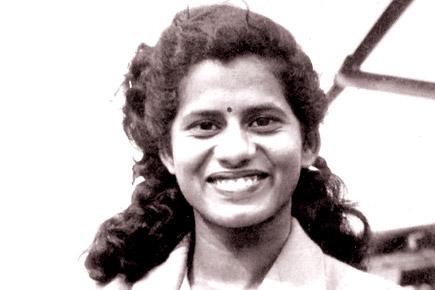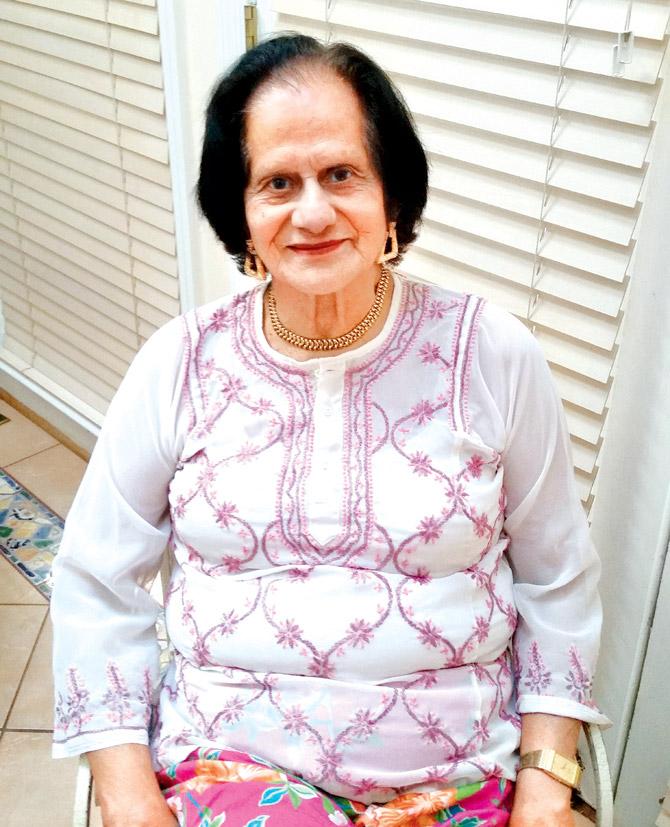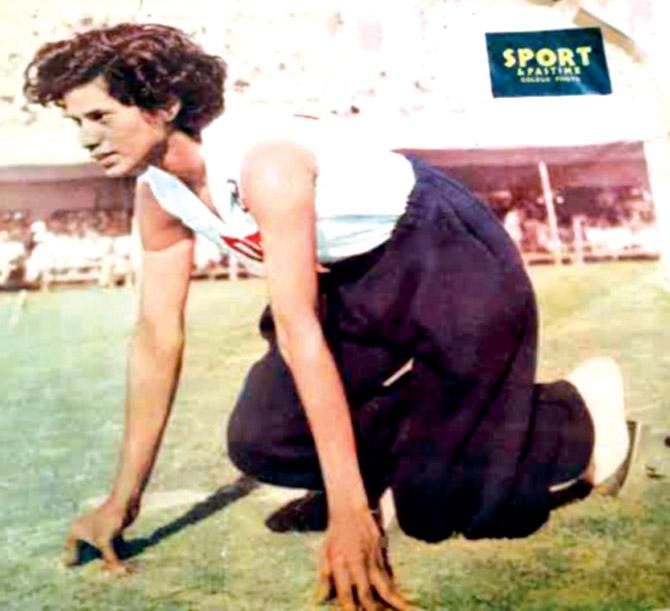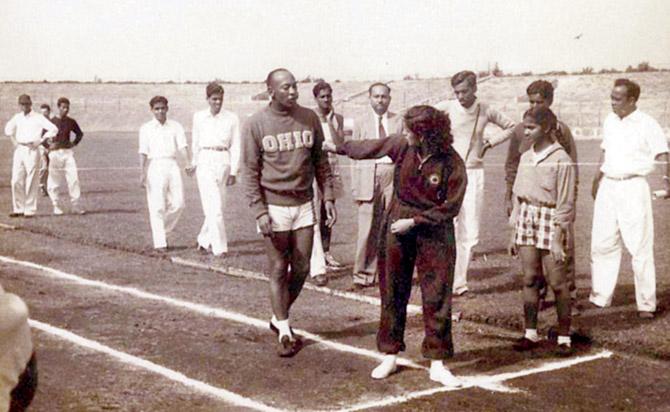India's first double international Mary Dsouza Sequeira disappointed at no recognition from Maharashtra for her athletics and hockey exploits; Mary (85) represented India in athletics and hockey in the 1950s

On Tuesday, Rio Olympians PV Sindhu and Sakshi Malik were honoured for their badminton silver and wrestling bronze medals respectively for the first time in Mumbai. Sindhu's felicitation at the opulent Crystal Room of the Taj was more significant to Mumbai since it was done at the hands of Maharashtra Chief Minister Devendra Fadnavis and initiated by the Maharashtra Badminton Association.
ADVERTISEMENT
Our Rio achievers deserve the hosannas, even the plethora of decorations and while celebrations continue, it is also a time for sports bosses to reflect on cases of omission in terms of honours. One athlete, who sticks out in that missed list, is Mary Dsouza Sequeira.
Mary (85) represented India in athletics as well as hockey in the 1950s and is an important part of Mumbai's sporting history. India's first double international would not have made it to the 1952 Helsinki Olympic Games if not for the Rs 5000 which was raised through a dance in Bandra. She also represented India in two hockey World events — London 1953 and Adelaide 1956, the year in which she could have made her second Olympic appearance. But with no financial backing, Mary couldn't make it to the Melbourne Olympics.
Only two female athletes made it to Helsinki - Mary and Nilima Ghose - and that makes them trendsetters in the sporting world of Indian women.
Mary won the 200m bronze and was part of the 4x100m relay team which won silver at the inaugural Asian Games in 1951. From 1950 to 1957, she held National records in 100m, 200m and 80m hurdles. Eddie Sequeira, the former middle distance runner, who represented India at the 1972 Munich Olympics, said he didn't watch Mary run in competitions since he was very junior to her, but was fortunate to see her train. "She used to train very hard. She was fast in the truest sense and always wanted to win medals for the country," said Sequeira.
In 2013, six decades after she kicked off her best sporting years as an India athlete, Mary was presented the Dhyan Chand award by the Ministry of Youth Affairs and Sports. Recallng the function held in the Capital, Mary's daughter Marissa, who is collaborating with her mother on an autobiography, says everyone were wondering who this elderly woman was, but in Atlanta (where Mary is at the moment, visiting Marissa), "she is treated as a celebrity."
Mary's pioneering forays are highlighted by Marissa, who said, "My mum went to the first Asian Games, was part of the first female contingent to the Olympics, played in the first hockey women's tournament in Folkstone, England and the first women's hockey tournament in Australia."

Mary Dsouza Sequeira. Pic/ Marissa Sequeira
Recently, Mary got invited to premiere of Race, the biographical film on legendary American athlete Jesse Owens, who Mary knew. Since Mary couldn't travel to Atlanta, Marissa and her husband Carl Chinoy attended the function on her behalf. One of Mary's prized possessions is an autographed photograph of Owens interacting with her on his trip to India in 1955.
In the evening of her life, Mary is content with all what sport has given her. However, she is not coy to state that she would be thrilled to see Maharashtra nominate her for the Padma Shree award be given the Jeevan Puraskar. Given her achievements on the athletic track and on the hockey fields, that is not asking for too much. We caught up with Mary for a chat facilitated by Marissa.
Excerpts:
Did you get a chance to follow India's 2016 Olympic show?
I was glued to the TV and my computer. I was visiting my daughter and there is an NBC application where one could see the Rio Olympics online. It was great as I got to see track events on TV and at the same time, I would view hockey, basketball, volleyball, football and pause and go back and forth. Modern technology makes it so enjoyable. You don't miss anything and I could see many events.

A page from the November 12, 1955 issue of Sport & Pastime magazine
Two Indian women returned with medals – badminton player PV Sindhu (silver) and wrestler Sakshi Malik (bronze). Your comment?
I am glad for the two medals, but I commend each and every athlete that donned the India colours. The motto of the Olympics, as Baron de Coubertin (the founder of Modern Olympic Games) said: "The important thing in the games is not to win but to take part. The important thing in life is not the triumph but the struggle. The essential thing is not to have conquered but to have fought well." It is easy for non-athletes to judge, but as an athlete one understands the hard work and sacrifice that goes into being the best in your field. The competition at the world level is stiff and sometimes you can be the best and expected to win. But you choke, you have a bad start, you get nervous. A lot of things happen. We are human. The biggest regret in my sporting career is not winning the 100m at the 1954 Asian Games in Manila. I can recall my sadness and regret even today. I had the fastest time in Asia of 12.3 secs and I was the favourite to win. But the Sri Lankan athlete next to me flicked the start twice and was disqualified. I got nervous and had a late start and then tightened. The officials too were to blame as they had all the fastest runners from all the countries in one heat, then the second fastest and then the third. This was a disadvantage to all of us in the heats and went unnoticed. We went on to win gold in the 4x100m relay with three of the fastest women in Asia.
Sindhu and Malik's medals apart, India's Olympic show was dismal. Would you put that down to a lack of encouragement by our officials and government?
Today's athletes have much more than I did by way of funds, endorsements and prize money when they return. I almost did not make it to the 1952 Olympics in Helsinki, as I came from a family of 12 children and my parents could not afford the Rs 5000. In 1952, that was a big sum of money. Friends and well wishers came to the rescue. A dance was held at St Andrew's in Bandra to raise funds for me. I was a teacher at St Joseph's Convent at the time and was only 21.

Mary Dsouza Sequeira in her glory days as an India athlete and hockey player. Pics/Mary Dsouza Sequeira's personal collection
What were the hurdles athletes like you faced in those days?
There was corruption, regionalism, favouritism even in my day. I was supposed to go to the Melbourne Olympics in 1956 and held the Indian record at that time. I was in top form, having played hockey at a tournament in Australia. I was visiting my brother in England when the Bombay Athletic Association chief told me that they were not sending a female contingent to the Olympics as the government would not fund it. Hence, I stayed on in England only to discover that the official sent his one daughter to compete and the other one as the manager. We have some great former athletes like Adille Sumariwalla, who are part of administration now and it is beneficial to have people like him, who have players' interests at heart.
Are you surprised that India has fallen to such depths in hockey, a sport you excelled in? Why do you think we don't match up to other teams?
Field hockey has changed dramatically. It is played on Astro turf and the rules have changed. For one, the Asian/Indian style is not conducive to Astro turf. It favours the Western style of hit and run. It is a much faster turf. Moreover, it is expensive to get and maintain. Mumbai and major cities have a lack of open grounds and facilities. Colleges and schools cannot afford Astro turf. Build and the results will come.

Mary Dsouza Sequeira with legendary American athlete Jesse Owens during his India visit in 1955
Are you disappointed that Maharashtra has not honoured you and that fact that the Central government appreciated your contribution to Indian sports very late?
I was born and bred in Bandra. It is sad that my state of Maharashtra has not given India's first double International ANY recognition. I applied for the Jeevan Puruskar award and have not got a response. It would like to receive this honour while I am alive and not posthumously. I served my country and state as an amateur and is it too much for the state to recognise me? Women who went as substitutes in the team have got awards, but not me. I have no political influence. I am grateful to the Centre for recognising me so my kids and grandkids can feel proud of me.
Tell us about your friendship with Jesse Owens. What sort of a man was he?
Jesse Owens was a great athlete and a kind, generous person who came to India (in 1955) and shared his skills with us. His movie 'Race' shows the hardships he encountered to get to where he did. My daughter Marissa and her husband Carl Chinoy went to the premier of Race in Atlanta, hosted by USA Track and Field (USATF).
Another great Olympian, who helped me was Harrison Dillard. He gave me his starting blocks at the 1952 Olympics as I did not have any. We too have a movie 'Bhaag Milkha Bhaag' and one on boxer Mary Kom. Kids of today should be inspired by these kind of Bollywood movies which are an integral part of India today.
What's your autobiography going to be like?
I am writing a memoir on my life and sports in India with my daughter Marissa. It addresses some of the cultural and social issues that I faced as an athlete. Yes, we have cultural issues, but the brave and beautiful women of India have always risen to the challenge. They often do jobs, take care of their families and perform as athletes. They are the true heroes of modern India.
What changes would you like to see in Indian sport and what have you observed about the American sporting culture which produces results?
In USA, there is no Sports Minister, no governing body. I see the commitment that my daughter Marissa puts into her kids' lives. My grandson Darius Chinoy runs track, so she became a USATF official to volunteer instead of sitting on the sidelines. She was an athlete herself and became a USATF coach, although she does not coach her son, so that she can be better informed. She became president of the High School Booster club to raise funds for the school and track & field athletes. Parents and grandparents are the kids' greatest cheerleaders and support in the West. My parents did not see me run or play hockey even once! In my time we had difficulties at various levels, but one thing that stood out was that the journalists always came to my help, be it to raise funds or report on my success. The reporting was fair and not sexually biased. I got adequate headlines as my male counterparts. The media published pictures to prove I was the winner when there was a cheating scandal and when I was being prevented to go to the Nationals. So be supportive of our athletes, a spirit of cooperation instead of criticism of our athletes will help. Don't forget India gave the world the Asian Games. I pray for my country that the best is yet to come.
 Subscribe today by clicking the link and stay updated with the latest news!" Click here!
Subscribe today by clicking the link and stay updated with the latest news!" Click here!






